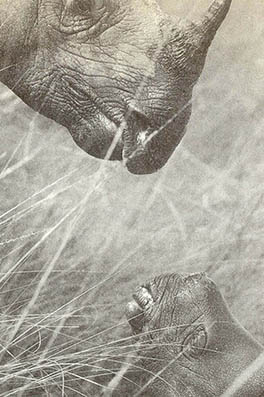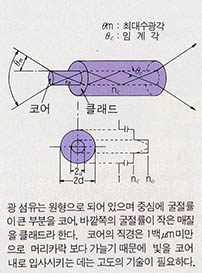
파충류나 조류(鳥類) 또한 감정을 거의 표현하지 못하는 얼굴들을 가지고 있다. 뱀은 화가 났을 때 '쉿' 소리를 내거나 독니(毒牙)를 드러낼 수 있지만 그것이 전부다. 당신의 잉꼬가 즐겁게 지저귀거나 부리를 부비는 것으로 반가움을 표시할 수는 있겠지만 웃지는 못한다.
개나 고양이의 주인들은 흔히 애완동물들의 털이 많은 얼굴이 좋은 감정을 보여줄 수 있다고 믿고 있지만, 대부분 포유동물의 얼굴 근육은 주로 위협을 표시하는데 사용되곤 한다. 편안하고 행복한 개의 얼굴 표정은 두려움에 떨거나 적의(敵意)를 가진 개의 표정과 분명히 다르지만 그것을 인간의 웃음에 견줄 수는 없다.
영장류(靈長類)는 잘 발달된 얼굴근육조직을 매우 효과적으로 사용한다. 최근의 연구들은 뇌 속 어디로부터 얼굴에서 감정을 표현하는 것이 기원하는가에 초점이 맞추어져 있다. 하버드 대학 인류학자인 마크 D.하우저는 겁에 질린 붉은털원숭이가 얼굴을 찡그리는 것을 비디오테이프에 담았는데, 보통 처음에 입의 왼쪽 가장자리가 움직이는 것으로부터 시작해서 다음으로 이어 진다.
오른손잡이인 사람들이 얼굴의 왼쪽 부분에 감정 표현을 더 잘하는 것이 뇌 우반구(右半球)가 감정을 드러내 보이는 것을 관장함을 가르킨다는 점은 이미 잘 알려져 있었다. 하우저의 연구는 모든 영장류에서 얼굴의 감정 표정이 주로 뇌 우반구에 의해서 통제받는다는 점에 대한 더 좋은 증거다.
캘리포니아주 팔로 알토에 있는 스탠포드 대학의 심리학자 펠리시아 프래토와 캘리포니아 대학 버클리 캠퍼스의 올리버 P. 존의 연구에 따르면, 우리의 뇌는 재빠르게 적의를 알아차리고 기억해서 위험으로부터 우리 스스로를 보호하도록 조정하는 것으로 보인다. 우리 인간들은 동물들이 이빨을 드러내거나 다른 사람들의 부정적인 말로부터 위험을 재빨리 감지해낼 수 있는, 이들 연구자들이 '자동적인 경계심' 이라고 부르는 것을 가지고 있다.
문제는 인간들이 정신 건강에 해롭거나, 해롭다는 사실을 깨닫고 그것을 그만두려고 해도 어쩔 수 없이 부정적인 것을 더 잘 감지하고 기억해 내는데 있다. 특히 그들 스스로 가망이 없다고 여기기 때문에 쉽게 포기해 버리는 비관론자들은 면역기능이 저하되어 더 자주 아프게 되는 경향이 있다.
이러한 인간들의 경향을 중화시키는 방법 중 하나는 부정적인 관찰들과 그로부터 생기는 때때로 비현실적인 부정적 결론들에 주목하는 것이다. 그런 다음 실제로 부정적인 것을 극복하는 한편, 현실적으로 희망적인 것에 초점을 맞추는 일일 것이다.
많은 사람들이 병의 치료에 낙관론과 웃음을 보조약으로 사용할 수 있다는 것을 알고 있다. 뿐만 아니라 펜실베이니아 대학의 심리학자 마틴 E. P. 셀릭만과 같은 연구자들에 의해 행해진 학습된 낙관론과 학습된 무력감의 관계에 대한 연구에 대해서도 알고 있다.
뇌의 신경전달물질이 어떻게 기분과 면역 체계에 영향을 미치는지, 그것들이 사람들이 생각하고 웃는 것에 의해 어떻게 영향을 받는지에 대해서도 또한 아주 많은 작업 이 수행됐다.
부정적인 것에 초점을 맞추는 인간의 오래된 경향을 완화시키는 차선책은 나로 하여금 웃음의 문제를 다시 돌아보도록 한다. 불상(佛像)들은 미소를 머금고 있는데, 사람들은 입가에 미소를 띠고 있을 때 훨씬 명상에 잘 잠길 수 있다고 한다. 허버트 벤슨 박사의 '긴장 완화 반응'과 찰스 F.스트뢰벨 박사의 '고요한 반성' 같은 기술도 미소를 띠고 있을 때 훨씬 효과가 좋다.
그러면 뇌의 생리를 변화시켜 행복하게 느끼도록 만드는 종류의 '진짜 웃음'은 과연 무엇일까? 이제 우리는 캘리포니아 대학 샌프란시스코 캠퍼스의 폴 에크만과 위스콘신 대학의 리처드 데이비슨 등과 같은 심리학자들이 말하듯이 그것이 어떤 웃음인가를 안다.
이들 연구자들은 인간들이 적어도 18종류의 웃음을 지을 수 있음을 알아냈다. 이 모든 웃음 중 하나만을 뺀 나머지는 소위 '웃는 척 ' 하는 것이다. 몇몇은 동물들이 위협을 표시하는 것에 가깝고 다른 몇몇 '사회적'인 웃음들은 거짓 웃음을 거듭짓는 악한인 햄릿의 의붓아버지가 짓는 웃음( 겉으로는 웃고 있지만 실제로는 자신의 내면 속에 있는 악을 감추고 있는)과 같은 것이다.
오직 한 종류의 웃음만이 웃음을 짓는 사람과 그것을 보는 사람 모두에게 진짜로 좋은 효과를 준다. 이 '진짜웃음'은 광대뼈와 연결된 주된 근육인 협골근(頰骨筋) 이 움직여 입술 가장자리로부터 생겨난다. 이것은 또한 안륜근(眼輪筋)을 움직이도록 만든다. 이 근육은 이름이 의미하듯 각각의 안과(眼菓)를 둘러싸고 있는 근육으로 우리가 자랑스러워할 만한 눈가 주름살의 원인이 된다.
만약 당신이 노력한다면 당신이 필요로 할 때 진짜 웃음을 짓는 능력을 계발할 수 있을 것이다. 그러한 의도적으로 유도된 웃음은 대뇌피질의 왼쪽 전두엽 부분의 활동을 증가시키지 못한다. 이 부분은 자연스럽게 일어나는 웃음에 의해서만 자극을 받기 때문이다. 그럼에도 불구하고 이것은 '꾸며진 웃음'과는 달라서 중요한 대뇌피질의 왼쪽 전반부의 활동을 증가시키기 때문에 진짜라고 부를 수 있다.
여기서 중요한 사실은 당신의 외부로부터의 노력이 내부에 영향을 미칠 수 있고, 당신의 기분과 면역 체계를 개선시킬 수 있다는 점이다. 그러니까 많이많이 웃기를 권한다.

Reptiles and birds also have faces that display little emotion. A snake may hiss and show its fangs when angry but that's about it. Your budgie greets you, with happy warbling and beak caresses, but it cannot smile.
The facial muscles of most mammals tend to be used mainly for threat displays, although dog and cat owners usually believe that the furry face of a pet can demonstrate positive emotion. Certainly the facial expression of a relaxed, happy dog is different from that of a frightened or hostile one, but it can't be compared to a human smile.
Primates use their extensive facial musculature to great effect. Recent studies have focused on where the facial emotional display originates in the brain. At Harvard University, anthropologist Marc D. Hauser videotaped the grimaces made by frightened rhesus monkeys and found that the left side of the mouth usually moves first, and more.
It had already been known that right-handed humans show more emotional expression on the left side of the face, indicating the dominance of the right cerebral hemisphere in displaying emotion. Hauser‘s study is more proof that the facial expression of emotion in all primates is controlled mainly by the right hemisphere of the brain.
Our brains seem to be geared to protecting ourselves from danger by quickly noticing and remembering the negative, according to a study by psychologist Felicia Pratto, at Stanford University in Palo Alto, California, and Oliver P. John of the University of California at Berkeley. We humans have what these researchers call "automatic vigilance," which makes us quickly recognize danger in an animal's display of teeth or in another human‘s negative words.
The trouble is, human beings are much better at noticing and remembering the negative even when it is detrimental to emotional health, and even when they are aware of doing so and try to stop. Pessimists, particularly those who easily give up because they consider themselves helpless, tend to have lowered immune function and get sick more often.
One way of counteracting this human tendency is to notice your negative observations and the often unrealistically negative conclusions you have draw from them. Then focus on the realistically hopeful while coping with the actual negative.
Many people recognize the use of optimism and laughter as adjuncts in healing, and know of the studies on learned optimism versus learned helplessness done by researchers like psychologist Martin E.P. Seligman of the University of Pennsylvania.
A great deal of work has also been done on the brain's neurotransmitters--how they affect mood and the immune system, and how they are affected by the way people think and smile.
Which brings me back to the smile, the second way of counteracting the Paleolithic tendency of humans to focus on the negative. Representations of the Buddha show him smiling, and it's said that meditation is better when done with a smile on the lips. Techniques like the "relaxation response" of Dr. Herbert Benson and the "quieting relex" of Dr. Charles F. Stroebel work better if done with a smile.
But what is a "true smile," the kind that changes the physiology of the brain so that you feel happier ? Now we know what that smile is, say psychologists Paul E㎞an, of the University of California at San Francisco, and Richard Davidson of the University of Wisconsin.
These researchers found that human beings are capable of at least 18 kinds of smiles. All but one are, so to speak, fake. Some are closer to the threat display of animals, and some "social" smiles are like those of Hamlet's stepfather, who could "smile, and smile, and be a villain."
Only one smile has a genuinely good effect on both the smiler and the recipient. That "true smile" raises the corners of the lips with the zygomaticus major muscle from the cheekbones. It also activates the orbicularis oculi which, as its name says, is the muscle that encircles each eye socket and causes the crow’s feet wrinkles we should be proud of.
If you work at it, you can cultivate a true smile when you need it. Such a deliberately induced smile does not increase activity in the left preforntal area of the cortex--that is stimulated only by a spontaneously occurring smile--but it is nevertheless called true because unlike "fake smiles" it increases the activity of the important left anterior area of the brain's cortex.
The point is, you can work from the outside in, improving your mood and immune system. So smile, smile, smile!
(c) 1994, Los Angeles Times Syndicate
















